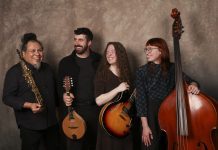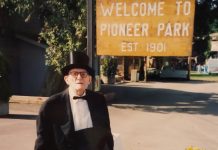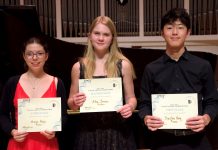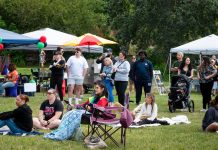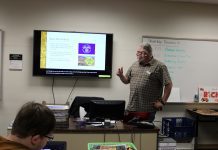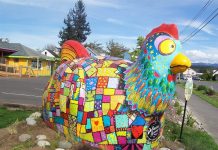My six and a half-year-old leads my husband and I to her “sit spot” in the 100-acre Wood at Fairhaven Park. After attending Forest Kindergarten and then Summer Camps through Feather & Frond Forest School, she’s learned to claim her place in the forest – to watch and listen, to decipher bird language and internalize the layers of awareness that arrive after returning to study the same place. As a family, we’ve reclaimed our forest senses beneath the wood’s ancient canopy, our knowledgeable child leading the way.
Patrick Fallon and Melissa Esposito Fallon have mentored our daughter into an awareness that’s crucial for our long term parenting goals – to provide opportunities for confidence and leadership, to give her access to life skills and tools that foster a deep sense of ecology and wonder, and an education that only the natural world can teach her. “There’s an ideal in the nature community,” said Patrick. “From children to elders we want to share our stories and be heard.” He points to a disconnect between the need for social connection and the once-removed attempt at achieving it through the internet. “Everyone is striving for human connection, whether they’re posting on social media or sitting around a campfire,” he elaborated.
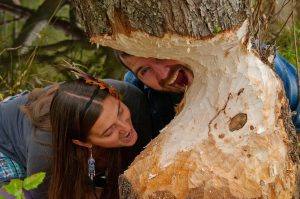
The community connection to nature begins within families. Melissa adds, “We are passionate about cultivating a multi-generational culture of nature connection and we see that being essential to the health and wellbeing of all humans. We are nature and we all benefit from seeing our parents and elders interact with nature.” Grandparent and Parent days are celebrated at their nature connection programs, allowing children to demonstrate knowledge and exchange wisdom with their elders.
As we meander down secondary trails less traveled, our daughter takes us to her favorite locations – Animal Hotel, Frog Swamp Flats, Butt Slide Hill, Stormy Tree and Huckleberry Hill. As the seasons have morphed, we’ve nibbled the edibles in and around the park. After her explanations of the subtle differences between the edible Red Huckleberry and mildly toxic Snowberry, for example, she’s taught us how to identify plants based on the shape of their stems. “See mom, how it’s square and green instead of round and brown,” she says.
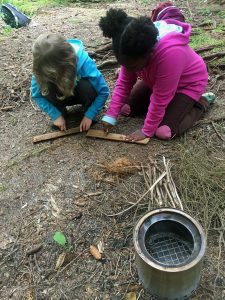
We find our daughter’s refined natural awareness to be impressive and yet to people who continue to live close to the Earth like the San Bushman in Africa, this awareness isn’t optional, it’s part of daily survival. Melissa quips, “What we know about nature is what a three-year-old might know in a traditional native culture.” When knowing a bird’s alarm call means avoiding being eaten by a large animal, forest wisdom is transferred from early childhood and becomes common knowledge. “The book of nature has no beginning and no end,” Melissa continues. “With one foot in the modern world,” she holds up her iPhone, “we are modern day people but we like to walk in both worlds.”
Prevalent in Europe, early childhood and nature-based education has increasingly become a national trend that aims to counter a tamed culture that can be devoid of natural world experience. “There’s a movement in this country – an awareness, interest and more social acceptance around entirely outdoor early childhood programming,” Melissa explained. She points to increasing scientific data that supports the benefits of nature immersion being good, “for all humans,” but particularly for young children and those with sensory issues who may struggle early on in the classroom environment. She cites Nature Deficit Disorder and the work of Richard Louv, author of Last Child in the Woods and co-founder of the Children in Nature Network.
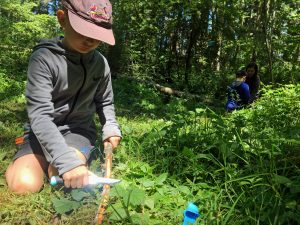
Nature pre-schools and outdoor kindergarten, as well as a wide range of wilderness programs, promote nature mentoring. The Fallons studied at Wilderness Awareness School in Duvall, WA, as well as leading youth nature immersion programs at WAS, Vashon Wilderness Program and others. “The folks at the Wilderness Awareness School are truly masters of this work,” Melissa reflects. The couple has trained with other renowned back-to-the-earth elders and have been immersed for over a decade translating the skills they practice and teach.
The Fallons speak highly of Jon Young, founder of WAS as well as the 8 Shields Institute, whose primary aim is to create a legacy of nature-based intergenerational communities worldwide. His motto, “The knowing is in the doing,” is at the heart of what the Fallons practice. They use “Coyote Mentoring” or the “Art of Questioning” as a way to draw out embodied learning by relying on their students’ innate awareness. Patrick points out that the ability to discover comes naturally, not by giving answers but by inspiring more curiosity so kids can discover their own answers, perhaps leading to an expanded recognition of nature’s diverse patterns.
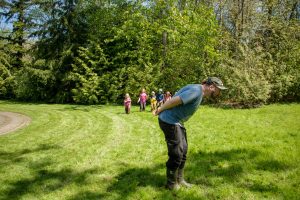
To keep the children’s attention, the husband and wife team get all their senses involved. Whether they are hyper-focused on knife skill training or teaching children how to start a fire with a tinder bundle and a spark, a keen focus on safety and teaching responsible stewardship are integrated into each lesson. Games like “Eagle Eye” (akin to hide and seek) support children using their deeper awareness as they crouch down in hiding places only to discover new flora and fauna. Children embody animals when hiking with “fox feet” and search for animal tracks on the way to the next survival shelter they’ll create out of downed limbs and moss. Cooking up and sampling maple tree blossoms, smearing Indian Plum on their faces and welcoming the mud are all in a day’s work for Feather & Frond Forest School kids and their passionate mentors.
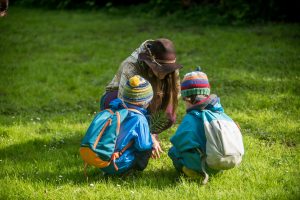
Feather & Frond Forest School is now enrolling their school-year nature connection programs for children ages 4-12. These range in commitment from one Saturday a month or an after-school program all the way to 1-3 day a week intensive programs for 4-6 year olds (Fox Walkers Forest Kindergarten) and 7-12 year olds (Fire Keepers Homeschool Enrichment Program). In addition, they will be running a once a month family program for younger kids and their parent called Deer and Fawn Days. Check out featherandfrond.org for more information.




